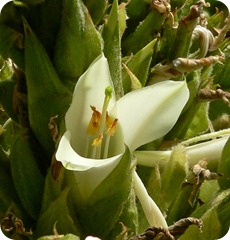The Titanca, spectacular endemic plant of the Andes, it blooms only once for a few weeks in its hundred years of life, then dies.
 Puya raimondii, also known as Queen of the Andes, is an endemic species of Bolivia and Peru, and whose distribution is restricted to the high Andes at an elevation of 3200 – 4800 m. It was the French scientist Alcide d'Orbigny (1802–1857) who was the first non-native person to discover it in 1830, in the region of Vacas, Cochabamba Department, in Bolivia at an altitude of 3960 m (12,992 ft).
Puya raimondii, also known as Queen of the Andes, is an endemic species of Bolivia and Peru, and whose distribution is restricted to the high Andes at an elevation of 3200 – 4800 m. It was the French scientist Alcide d'Orbigny (1802–1857) who was the first non-native person to discover it in 1830, in the region of Vacas, Cochabamba Department, in Bolivia at an altitude of 3960 m (12,992 ft).
The name of Puya raimondii commemorates the Italian scientist Antonio Raimondi (1826–1890), who resided in Peru for many years and made wide botanical explorations there.
He discovered this species later in Peru in the region of Chavín de Huantar and published it as Pourretia gigantea in El Perú, Volume 1, Page 297 . In 1928, the name was changed to Puya raimondii by the German botanist Hermann Harms.
 This plant has a gigantic inflorescence that may reach up to 10 m height, with more than three thousand flowers and six million seeds in each plant. Its reproductive cycle is approximately 40 years.
This plant has a gigantic inflorescence that may reach up to 10 m height, with more than three thousand flowers and six million seeds in each plant. Its reproductive cycle is approximately 40 years.
One planted near sea level at the University of California Botanical Garden, USA, in 1958 grew to 7,6 m (24 ft 11) in and bloomed as early as August 1986 after only 28 years. It is not only the largest of the Puya species, but also the largest Bromeliad. It can reach 3 m tall in vegetative growth, with a flower spike 9–10 m tall.
Like most Bromeliads, it dies soon after flowering. It is considered to be an endangered species. Seeds were collected of P. raimondii in 1999 and 2000 of the rodales of Huashta Cruz (district Pueblo Libre, Ancash region, Peru), near the city of Caraz. It is also known to grow in the Masma Chicche District of Jauja Province.
Only 45 km West from Caraz (Ancash - Peru) at 4200m above sea level, at Huashta Cruz, on the Cordillera Negra, there is a "rodal" of puyas, with an impressive 145 km view of the Cordillera Blanca. The place is known as "Huinchus", and the Giant Hummingbird (Patagona gigas) is often spotted here.
These plants are mainly located in the three important places of Ancash: the gully of Ingenio in Catac, the punas of Cajamarquilla and the gully of Queshque, also in Catac.
In Bolivia - apart from Vacas Municipality where these plants are spread on an area of about 1 km² - the only other place to find Puya raimondii is Comanche mountain in Caquiaviri Canton, Caquiaviri Municipality, Pacajes Province, La Paz Department.
Conservation status
Endangered










Comments
Post a Comment